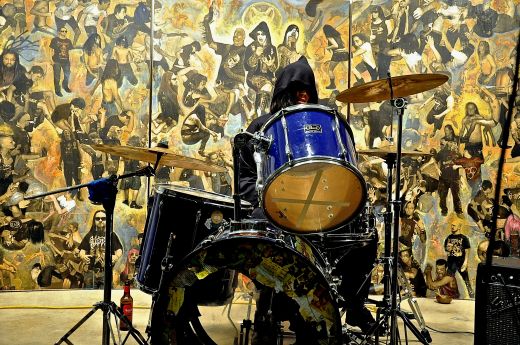
Snakehole (drummer KC Toimil) performing at the opening. Behind: Niuvis Martin, Paradise, 2012. Photo transfer on wood/collage/mixed media, 6 x 12'. Photo courtesy Art and Culture Center of Hollywood.
September 6 – November 2, 2014
Echos Myron, co-curators Beatriz Monteavaro and Priyadarsini Ray’s exhibition of visual artists and musicians working shoulder to shoulder in South Florida, is a celebration of their scene. It’s a happily crowded show, but I didn’t notice any of the Wynwood-style art that would be a nod to hip-hop’s enormous influence on visual culture. Here, the aesthetic is punk and music is mostly shorthand for rock n’ roll.
Monteavaro’s and Priyadarsini’s statements on the wall at the entrance emphasize the cross-disciplinary, collaborative spirit they encounter working as both visual artists and musicians. Lyrics from a Guided By Voices song, from which the show’s title was gleaned, are also printed next to the statements. Looking for clues to the curators’ intentions, I studied Bob Pollard’s cryptic lines for meaning. In a stark contrast to the statements, they seemed jaded and cuttingly ironic.
The works are accompanied by artist statements that read like oral histories. Someone could separate the art into categories: visual art about music or set in the music world, art by artists who make music or experiment aurally, and visual art made by musicians. A fourth category might be visual art made and consumed inside the music scene as opposed to the traditional gallery system. In a simple intervention, the curators also gave the show a soundtrack: a collection of songs by many of the participating artists that plays throughout the space and relaxes the gallery environment.
Collage, the visual medium that ties punk to its Dada roots, features in Autumn Casey’s tawdry “Timeless Viscosity.” The piece demonstrates the subversive immediacy of images appropriated from mass media. A ragged Life magazine cover featuring rock casualty Elvis Presley on the front and a sexy Bacardi ad on the back is the lynchpin of this life-size assemblage mounted on cellophane-covered wallboard. The work also contains photos of both the artist and her mother that echo the women’s bodies in the magazine ad, a guitar case made of gummy worms, but most disturbing/titillating is the weird web of filaments in one corner that somehow suggests ruined panties.
Clifton Childree’s “Saltwater Taffee” and Gavin Perry’s “Death Goes to the Winner” dance with the suggestion of movement. Childree’s piece, a bending stack of chairs separated by plywood sheets, seemingly droops in stop-motion decay. The resin-coated plywood looks like it’s been rotting under a mango tree whose pits still litter its surface. Next to it, Perry’s careening, splitting loop of bent rebar also drips with toxically colored resin. His title, borrowed from a song by sludge-metal band, Harvey Milk, promises ecstatic destruction.
Excess is the primary medium in Kevin Arrow’s “Untitled (Dead Tape Collector, Jeff).” The collection of posters, an interview, and over a hundred Grateful Dead Bootlegs tapes is grim in its uncertainties. Who was Jeff? Is he as dead as the title implies? What does it mean that all that’s left is a symbol of geeky rock n’ roll obsession? It comes just before the last part of the show, which is filled with the kind of drawings and prints made for, or around the music scene, under the influence of alternative comics, body art, psychedelia, etc. More than decorating promotional materials and merch, artists like Jean Saiz and Chris Garcia lovingly create imagery that serves as a pictographic language and visualization of underground music’s politics and mythology. Nearby, photos by Teajay Smith document the fleeting exuberance of live shows at legendary Miami venue, Churchill’s. On the floor, in the center of the room, is “Jeans Embodiment” by Janese Weingarten, a pile of cushions made by sewing canvas over the openings of half a dozen pairs of denim jeans, suggests a mosh pit or just a pile of stuffed crotches.
Like the song whose name it shares, Echos Myron trades in darkness, but still feels like a celebratory anthem. Considering the quality and quantity of work made in South Florida’s climate of relative indifference and willful ignorance towards all the arts, that makes sense.










